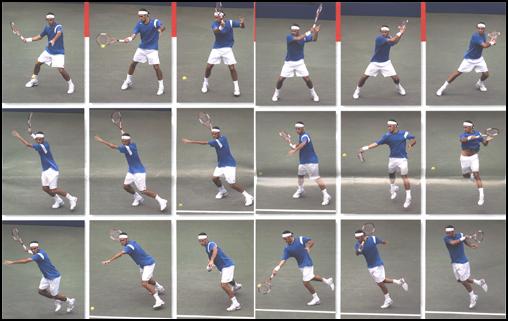Revolutionary Tennis |
||
Tennis Instruction That Makes Sense |
||
Head-On
THROUGH THE LOOKING GLASS -- F/H OPEN STANCE = INJURY Here is a good example of tennis world dysfunction that hurts the game. And you thought your struggles were your fault! Doubt no more. The USPTA (United States Professional Tennis Association, a teaching organization) promotes the open stance and calls it "modern tennis." But the USTA (United States Tennis Association, the national governing body for the sport) warns that an open stance leads to hip injuries. And there's more.
Next we have the USTA's High Performance Coaching newsletter Vol. 8, No. 2/2006 that warns the open stance causes hip injuries and uses similar photos of Gustavo Kuerten. From the USTA. "Hip Injury and the Open Stance Forehand" Potential Problem
Implications for Injury The repetitive loading of the right hip in a right-handed player can lead to injury to the hip joint itself as well as the hip's stabilizing structures: the joint capsule, labrum, and the muscles and ligaments that support this joint. Players who repetitively load the hip can develop an injury to these structures, especially when strength imbalances and poor flexibility exist in this region. Research has shown that repetitive tennis play can create loss of motion in the hip joint. Players need excellent strength and flexibility in the hip to execute this shot properly. The exercises and stretches detailed in this newsletter can help prepare the player to handle the loads while decreasing the risk of hip injury [Monster walks, figure 4 stretch shown in doc]. END Why the incongruity? Do we show you how to hit the stroke one day and who-knows-when later say this method can lead to hip injury unless you're strong and flexible enough? The USTA allegedly shows you "what the pros are doing" and then backpedals to cover its ass. Would they recommend using steroids but caution they can be a health hazard? The USTA must take a stand on the open stance. They don't because their literature clearly shows they don't understand it, they throw everything at you and the kitchen sink and later tell you to duck. Next time a "certified" tennis teacher tries to sell you on "loading" for more power with an open stance forehand to "lift your game one level" ask if his/her member organization has gotten around to the exclusions to said technique s/he's selling you that week, i.e. potential injuries, restrictions, shortcomings. Finally, to show you the lack of cojones in the USTA and in the major celebrity teaching voices, I point you to TENNIS magazine's latest how-to from Eliot Teltscher as he looks at top ten touring pro Nikolay Davydenko's forehand. Eliot, a former top ten player himself and now former Director of Player Development at the USTA after this analysis, absolutely loves Niko's forehand shown as he hits off the front foot.
Photo 1: "...With the ball coming right to him, there's no reason this forehand needs to be hit with an open stance." Photo 2: "...Davydenko's weight has shifted from his back foot to his front...." Photo 3: "In this photo you see even more evidence that Davydenko is exploding up and forward into this shot..." Photo 4: "...And while Davydenko is off the ground, this is a result of his momentum, not because he jumped at the ball, which is something I see a lot of players do in a misguided attempt to get more pace." [Davydenko photos, TENNIS magazine August 2006, Tommy Hindley / Professional Sport.] Now I know Eliot has cojones, but he alone can't/couldn't change the stodgy USTA. Of special note is how the USTA shows Guga on a clay court and behind the baseline where he's most comfortable and definitely to be emulated, but the tennis-teaching USPTA shows the clay court master not only on a hard court but inside the baseline where he is ill at ease. Clueless. Now here comes the "more" part. Gotta shake your head. The photos the USPTA uses in their example have been altered to satisfy their thesis. The vertical axis of rotation keeps the same distance from the center hashmark in both photos 1 and 2 (reading left to right), but in photo 3 the axis has been moved closer to the hashmark to line up with Kuerten's back hip after his rotation and thus coincide with their thesis.
You can see the center hashmark in photos 1 and 2 just inside Kuerten's left knee and then left calf muscle. In the photo below a reference mark connects the baseline, the vertical axis, and the hashmark and is shown identically over all three photos. If the USPTA's thesis were accurate the obvious change in photo 3 would not stand out. Shame on them for doctoring the photo.
Why the fudge? Because the USPTA's idea of the rotation occurring at the back hip is incorrect. In the USPTA sequence the outside leg serves as a pivot point, not an axis of rotation, as his two feet on the ground show. This is further borne out by the following photos where the axis of rotation is placed through Kuerten's center, and its placement holds true to the last photo.
If the arm and core "rotate" around an axis defined by the back leg as opined by both the USPTA and USTA then this rotation is by definition imbalanced, and imbalances cause injuries. Why? On one side of this faux axis defined by the back leg you have just the arm in motion during the swing with a racket in the hand while on the other side of the axis you have at least two-thirds of the body's mass and weight, if not more, pulling at the lesser side. The fact Kuerten spins around and lands on both feet should indicate to the USPTA where the axis of rotation lies.
Perhaps the idea of either loading the outside leg or using it as the axis of rotation should be looked at in a more circumspect manner. It is the point of view of Revolutionary Tennis that the axis of rotation, when present in the open stance forehand, does not lie through the back leg/hip but instead lies through the body's center. If the player "loads" on the back leg a re-balancing mechanism needs to take place in order to avoid injuries to the back hip. The re-balancing mechanism is simple, body weight needs to shift onto the front foot. The footwork form for this is the Open Forward Stance promoted on this web site. Its main advocate is Roger Federer (and Agassi, Sampras, and others).
The Federer photos are from the USTA's High-Performance Newsletter Vol. 6, No. 4/2004. The first series is a serve return, the other two groundies in play. There is a concerted effort not to spin on one leg or rotate like Kuerten's example. Federer also has more footwork looks: he does rotate on his back leg and lands on his back leg, he does spin around in a quarter circle transposing back foot to the front and vice versa. But for the majority of his forehands he chooses to put the front foot in there somehow, he lands on it.
When the USTA says: "However, even when performed properly, the loading of the dominant side hip is an inherent characteristic of the open stance forehand and must be considered when preventing and/or treating injuries in the lower body," it is not the loading that must be considered but its release form. Loading on the back foot only to explode into the shot and land or remain on the back foot as shown in both Kuerten examples above leads to hip injury. No amount of flexibility or strength would abrogate this reality. Exploding onto the front foot in one manner or another mitigates this concern. One always loads, it is the unloading process the USTA and others need to look into first to help prevent injury and help you play tennis better, not the open stance. How much loading is considered necessary or realistic is another area to dissect. And what is more important, the loading or unloading? And aren't we already loading when moving to the ball? This reminds me of how all the tennis books advocated extending the stroking arm straight out as far away from the body as possible to increase power since in physics the longer the lever the greater the torque for more power in your stroke. Even for two handed backhands. This is slowly being retracted since it does not apply to tennis. We want acceleration, speed, repetition. The same awareness will eventually happen with this loading, exploding, body rotation thing. While in principle rotating the body and unwinding the kinetic chain results in most power, its use does not translate effectively to the reality tennis encompasses. The best way to avoid this potential hip injury is to hit off the front foot. Now why is this so difficult to say, why don't we teach this as the bread-and-butter to terrific tennis technique? The open stance is not the overarching technique that leads to terrific tennis. It is a sidebar. ADVICE The forehand open stance where you rotate solely on the back leg and are unable to step onto the front foot first after contact is a counter measure stroke needed in the tennis player's arsenal. This stroke is a defensive stroke though it can be hit with power. But do not be confused with the apparent power, repeated use of this back-leg-only shot wrecks the hip joint and should be avoided in favor of striking the ball with better composition that offers less potential for injury. Getting to the ball early to set up, load, and explode while only on the back leg is a good effort wasted. Instead by all means plan to use your front foot for a better shot. Use an open stance forehand if you are late reaching the ball or are quickly rushed, if you have a habit of stepping across the ball's flight line too much, if you have difficulty seeing the ball well or need to buy some time, or if you just can't get the hang of easily stepping into the ball with the front foot. But don't use the open stance to load and unload for power, the Forward Stance and Open Forward Stance already allow for that and with fewer headaches. Less is more. Though often not with my verbiage, my apologies. FYI: Two members of the USPTA Player Development Advisory Council have been singled out to me regarding this USPTA newsletter, Mr. David T. Porter, Ed.D., and Mr. Paul Roetert, Ph.D. Mr. Porter, USPTA Education Committee chair, chose the Kuerten illustration; Mr. Roetert, the Managing Director of Player Development for the USTA and who also represents the USTA High Performance Coaching Program, vetted the USPTA newsletter before publication. Download the PDF USPTA Newsletter, the USTA Hip Injury newsletter and USTA Federer Forehands newsletter and check 'em out for yourself in depth. |
||
|
|
||||||||||||||||||||||||||||||||||||||||||||||||||||||||||||||
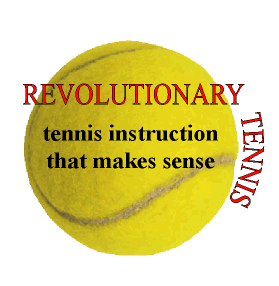
 But first the tennis-teaching USPTA promotes and instructs what they call the "modern" forehand to its membership. In their Player Development Program newsletter Volume 3, No. 1, February 2006, "Anatomy of a modern shot," they write, "...We repeatedly use the term "load - explode - and land" to explain the basic mechanics of modern groundstrokes as hit by experienced players. Loading the outside leg for a groundstroke provides the axis around which the core and arm rotate, generating angular momentum (see Exhibit II)." [bold type is mine.] Exhibit II shows Gustavo Kuerten in an open stance inside the baseline on a hard court. A vertical pole representing the axis of rotation is drawn through his back hip and a circle around his waist illustrates rotation.
But first the tennis-teaching USPTA promotes and instructs what they call the "modern" forehand to its membership. In their Player Development Program newsletter Volume 3, No. 1, February 2006, "Anatomy of a modern shot," they write, "...We repeatedly use the term "load - explode - and land" to explain the basic mechanics of modern groundstrokes as hit by experienced players. Loading the outside leg for a groundstroke provides the axis around which the core and arm rotate, generating angular momentum (see Exhibit II)." [bold type is mine.] Exhibit II shows Gustavo Kuerten in an open stance inside the baseline on a hard court. A vertical pole representing the axis of rotation is drawn through his back hip and a circle around his waist illustrates rotation.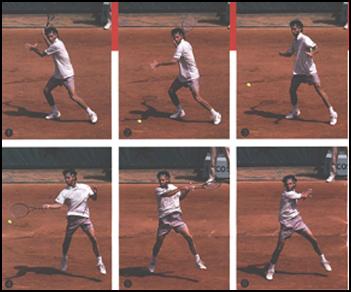 As Gustavo Kuerten performs an open stance forehand, pay attention to pictures 2-4 as he loads and subsequently hits off the right leg and hip. In the open stance forehand, the muscles and structures spanning the right hip are required to absorb large forces (pictures 1-2). This is followed by explosive concentric contraction of the same muscles (pictures 3 and 4), producing the power that is needed from the first links of the kinetic chain The forces generated by the legs and trunk are ultimately transferred through the kinetic chain to the upper body. Interestingly, most would argue that this is a properly-executed stroke. However, even when performed properly, the loading of the dominant side hip is an inherent characteristic of the open stance forehand and must be considered when preventing and/or treating injuries in the lower body.
As Gustavo Kuerten performs an open stance forehand, pay attention to pictures 2-4 as he loads and subsequently hits off the right leg and hip. In the open stance forehand, the muscles and structures spanning the right hip are required to absorb large forces (pictures 1-2). This is followed by explosive concentric contraction of the same muscles (pictures 3 and 4), producing the power that is needed from the first links of the kinetic chain The forces generated by the legs and trunk are ultimately transferred through the kinetic chain to the upper body. Interestingly, most would argue that this is a properly-executed stroke. However, even when performed properly, the loading of the dominant side hip is an inherent characteristic of the open stance forehand and must be considered when preventing and/or treating injuries in the lower body.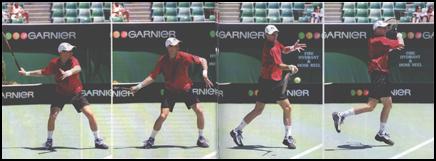



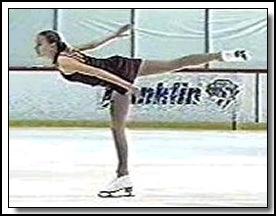 If the back leg really were to act as an axis of rotation the front leg would remain in the air longer and the player lands on the back leg, as the USTA's photos above illustrate ironically. A good example where one rotates around a single leg/axis is the camel spin in figure skating seen in the photo (caption reads: Carla Korte / flint 4 Seasons FSC), but tennis players never really look like this.
If the back leg really were to act as an axis of rotation the front leg would remain in the air longer and the player lands on the back leg, as the USTA's photos above illustrate ironically. A good example where one rotates around a single leg/axis is the camel spin in figure skating seen in the photo (caption reads: Carla Korte / flint 4 Seasons FSC), but tennis players never really look like this.